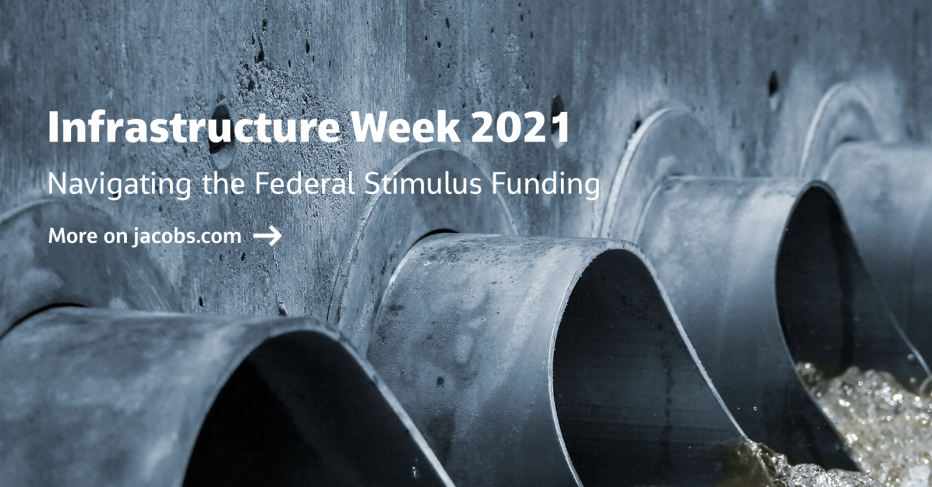
Stimulus legislation, both the Rescue Plan Act and the developing infrastructure bill, are creating opportunities for utilities to get essential funding for critical infrastructure projects.
In this article Mike Matichich, Jacobs’ lead for our Financial Services consulting team, highlights details on the federal funding available and the opportunities to secure that funding to accomplish priority water and wastewater system needs.
Today marks the beginning of Infrastructure Week. This is a great time to pause and take stock in what a difference a year makes for the water industry. Last year at this time, several of our clients at water and wastewater agencies shared with me their need to re-prioritize project decisions to account for reduced revenues. Many of these discussions focused on establishing policies to curtail disconnecting service for low-income customers, who were plunged into further financial distress from pandemic-related business impacts.
This year, while many financial challenges linger from a year framed by a pandemic economy, there is an emerging optimism and planning for recovery across the water industry. Vaccination progress means that more people are returning to work; the foundation for overall economic recovery. Conversations are now shifting to advancing utility capital and operational initiatives that have been sidelined during the past year.
Two large Federal stimulus bills – the already-signed American Rescue Plan Act and the American Jobs Plan Act working its way through Congress – provide further optimism by boosting the economic health of the nation’s utility systems. This legislation creates financing opportunities to advance high-priority water capital programs and operating initiatives to improve service to utility system customers.
In locations as diverse as Alaska, California and Georgia, many water and wastewater agencies don’t expect to get significant funding for capital projects from the $350 billion that has been made available to state and local agencies for fiscal recovery. The expectation is that funds received and overseen by mayors, city councils and county governing have many competing requests, including urgent health-care initiatives and support to COVID-related vaccine efforts. Even so, many water agencies will benefit significantly from the Rescue Plan Act as:
- Many utilities are helping their low-income customers to qualify for a portion of the $500 million that was made available through the Rescue Plan Act to address payments that are in arrears due because of pandemic-related financial stress on customers.
- Employment opportunities that arise from the $1.9 trillion Rescue Plan Act enable more customers to pay their bills going forward.
To seed capital projects that have been halted during the pandemic, many utilities will need to look toward direct Federal stimulus funding anticipated to be included in the American Jobs Plan Act. This is expected to be passed and signed into law sometime this summer. The current Biden Administration version of the bill includes substantial funding for water industry projects including:
- $56 billion in water, wastewater, and stormwater funding, most of which will be low-interest loans administered through the state agencies that administer the state revolving fund loan programs.
- An additional $45 billion in funding for addressing lead service line issues.
- Pockets of funding that water agency projects might qualify for, such as funding for resilience, sustainability and addressing environmental justice and social equity needs.
In a recent brochure, we outlined some of the activities that water agencies could use to help maximize their opportunities to access the Federal stimulus money for priority projects and initiatives such as revisiting project prioritizations, scenario planning, updating financial forecasts and plans to incorporate potential federal funding and positioning in Washington for federally-directed portions of the funds.
Because environmental justice and social equity disparities in many cases have been compounded by the financial downturn of the past year, it is more important than ever that social equity objectives be embedded into how water and wastewater capital programs are developed and implemented during the recovery. Fortunately, the High Road Handbook that I had the opportunity to help develop a couple of years ago provides a framework that can be used to help realize this important goal.
I look forward to continuing the dialogue on how the water industry can take best advantage of the federal stimulus funding by participating in a webinar with several industry peers this Wednesday. Register to join us today.
Mike Matichich leads Jacobs’ Financial Services consulting team. He has more than 30 years of experience in helping water, wastewater and stormwater utilities develop and implement successful funding and financing plans for their capital programs.












































